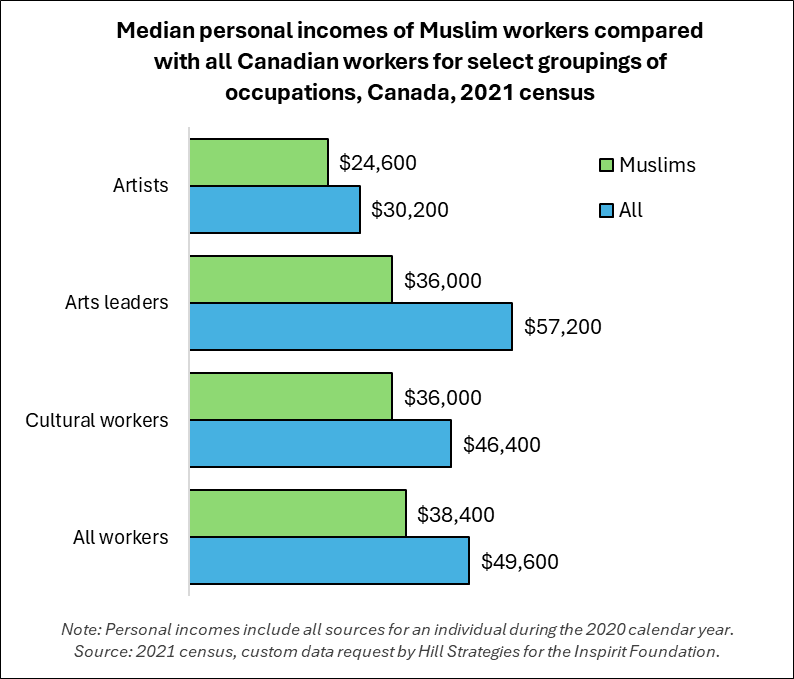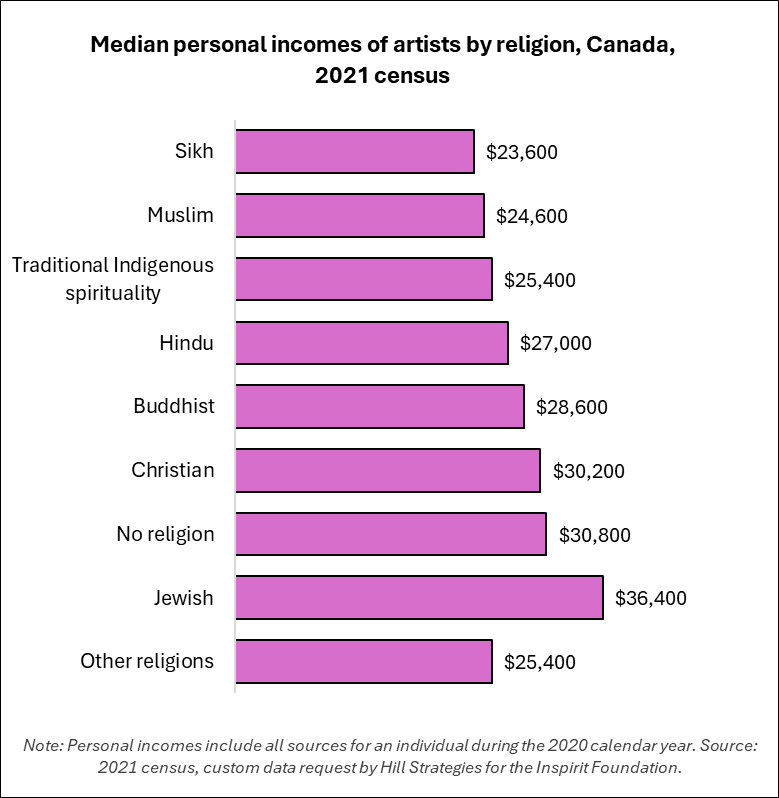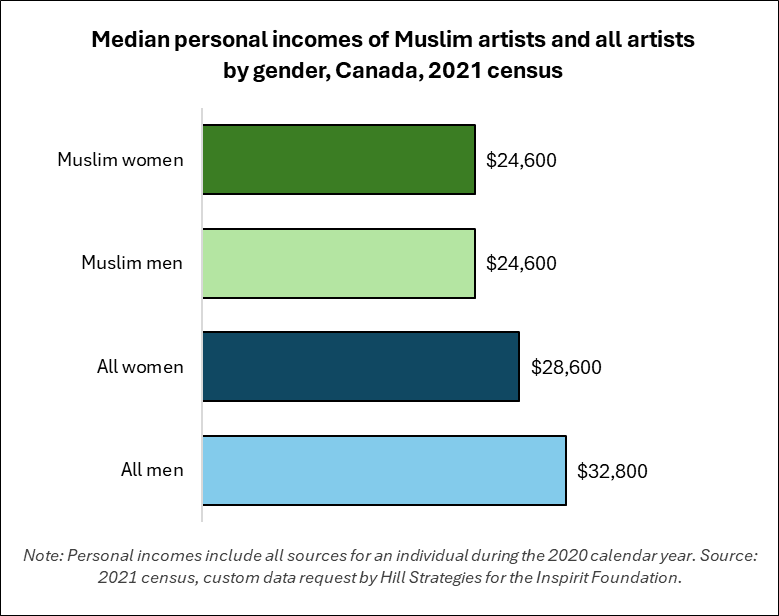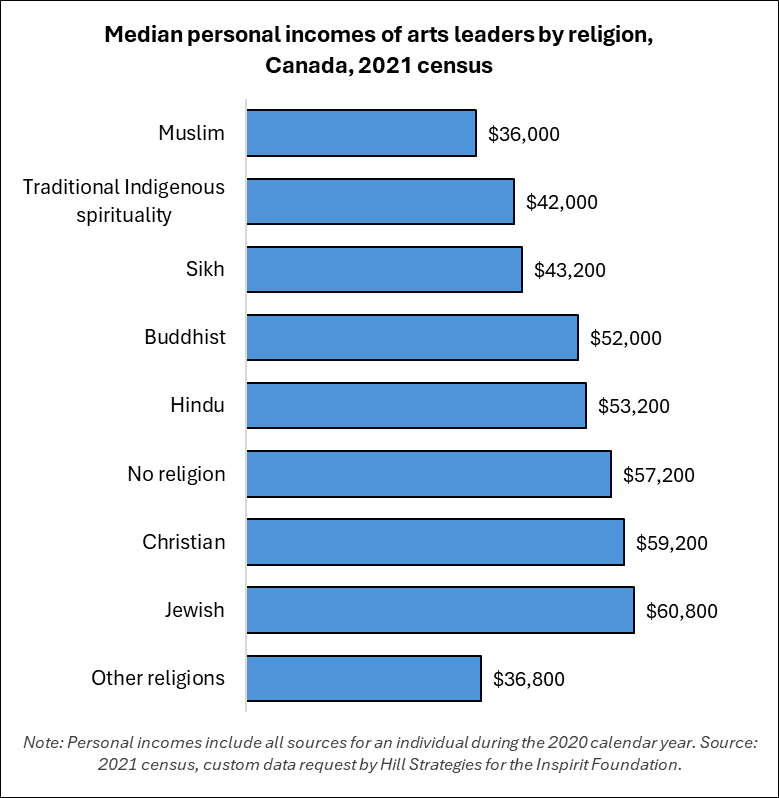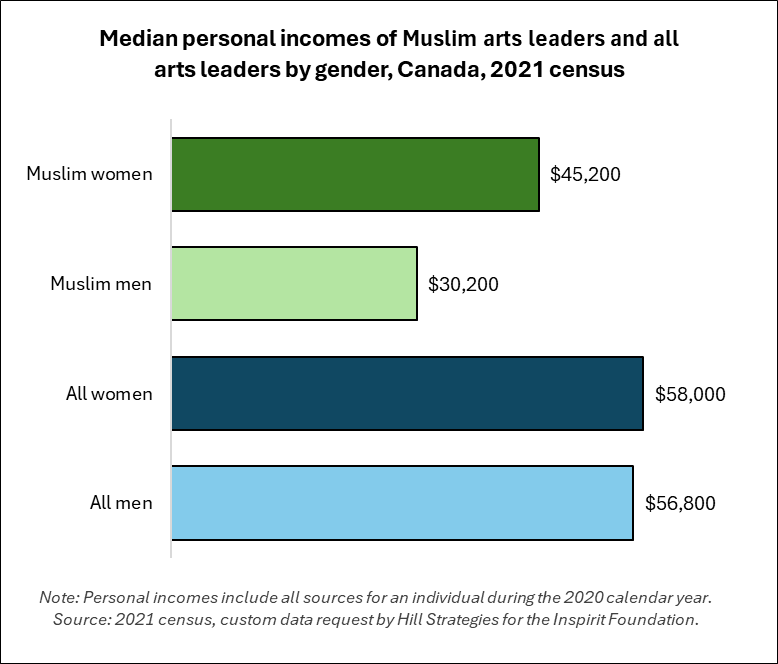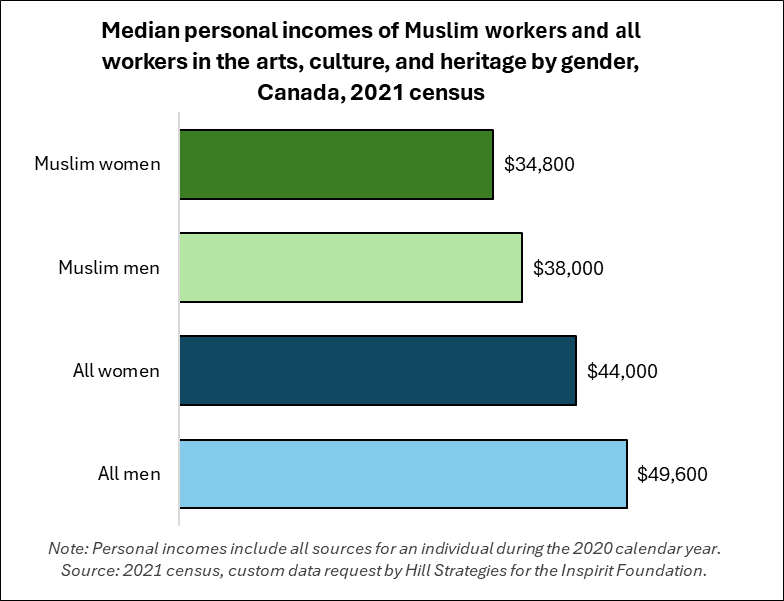Incomes in the arts and culture are particularly low for Muslim workers
Analysis of the incomes of artists, arts leaders, and all cultural workers, including differences by gender
This report examines the median incomes of Muslim workers and all workers within four broad groupings of occupations: artists, arts leaders, workers in cultural occupations, and all Canadian workers. Differences between women and men are highlighted.
The report examines income statistics for artists as a group, for arts leaders as a group, and for cultural occupations as a group – not for individual occupation categories (e.g., writers, actors, performing arts managers, etc.).
Median personal income is the key statistic used. This statistic includes all sources of income, including (for example) employment income and pandemic supports. The income statistics from the 2021 census relate to 2020, a year with many pandemic lockdowns and slowdowns in artistic activity.
Details about the occupation groups included in each of the broad categories are available at the end of this post, along with other notes regarding methods.
This article is one of two released today, both commissioned by the Inspirit Foundation. The other statistical article, on Muslim representation in the arts, culture, and heritage, can be found here. A full report on the Muslim Artists Live Here project, containing qualitative information and select statistics, is available on the Inspirit Foundation website.
Muslim workers tend to have much lower incomes than other Canadians
The following graph shows that Muslim workers have much lower median incomes than other Canadian workers in the arts and culture, as tends to be the case throughout the economy.
Muslim artists have a median income of $24,600, which is 19% lower than the median for all Canadian artists ($30,200).
Muslim workers in select senior occupations in the arts (“arts leaders”) have a median income of $36,000, or 37% lower than the median for all Canadian arts leaders ($57,200).
Muslim workers in the arts, culture, and heritage (“cultural workers”) also have a median income of $36,000, which is 22% lower than the median for all Canadian cultural workers ($46,400).
In the Canadian economy as a whole, Muslim workers have a median income of $38,400, or 23% lower than the median for all Canadian workers ($49,600).
The rest of this report explores median incomes by gender for these groupings of occupations.
Artists
The following graph shows that Sikh and Muslim artists have the lowest median incomes ($23,600 and $24,600, respectively) among all groups of artists by religion. The median income of all Canadian artists is $30,200.
Median incomes are equal between Muslim men and Muslim women who are artists, contrary to the situation for all artists, where women artists have much lower incomes than men. As shown in the graph below:
Men artists have the highest median income ($32,800).
Women artists have median income of $28,600, 13% lower than men.
For the 1,950 Muslim men artists, the median income is $24,600, 25% lower than all men who are artists.
For the 1,980 Muslim women artists, the median income is also $24,600, 25% lower than all men who are artists.
Arts leadership occupations
As shown in the following graph, Muslim arts leaders have the lowest median incomes ($36,000) among all groups of arts leaders by religion. The median income of all Canadian arts leaders is $57,200.
The graph below shows that, among arts leaders:
The median personal income is the similar for all men and women who work in one of five arts leadership occupation groups ($56,800 for men and $58,000 for women).
The 520 Muslim men who are arts leaders have a median income of $30,200, 47% lower than the median for all men who are arts leaders.
The 380 Muslim women who are arts leaders have a median income of $45,200, 20% lower than all men who are arts leaders.
It is unusual and interesting that Muslim women who are arts leaders have much higher median incomes than Muslim men. It is also interesting that all women who are arts leaders have median incomes that are at least equal to all men. These statistics seem to indicate that, when they obtain arts leadership positions, women are paid relatively well.
A more thorough analysis would be required to better understand these findings, including the mix of arts leadership occupations occupied by women and men, education levels, work experiences, and differences in employment (and household) incomes, not just total personal incomes.
All workers in the arts, culture, and heritage
Among workers in all cultural occupations, Muslim workers have the lowest median incomes ($36,000) of any religious group, as demonstrated in the following graph. The median income of all Canadian cultural workers is $46,400.
There is a substantial income gap between women and men who are cultural workers, including among Muslim women and men:
Men cultural workers have the highest median income ($49,600).
Women cultural workers have a median income of $44,000, 11% lower than all men.
The 13,600 Muslim men who are cultural workers have a median income of $38,000, 23% lower than the median for all men.
The 14,100 Muslim women who are cultural workers have a median income of $34,800, 30% lower than all men.
Context: Muslim workers and all workers throughout the economy
The following graph shows that, throughout the economy, Sikh and Muslim workers have the lowest median incomes ($38,000 and $38,400, respectively) among all groups of workers by religion. The median income of all Canadian workers is $49,600.
As shown in the graph below, men have by far the highest median personal incomes among all workers in the Canadian economy. Women have much lower median incomes, and Muslim men and women have even lower median incomes. Specifically:
Men have a median income of $54,400.
Women have a median income of $45,600, 16% lower than men.
Muslim men have a median income of $39,600, 27% lower than the median for all men.
Muslim women have the lowest median income ($37,200, or 32% lower than all men).
Notes on methods, including occupation lists
The analysis is based on data from the 2021 census.
Data on Muslim workers are drawn from the census question: “What is this person’s religion?” This was a write-in question that included the following notes and tips:
“Indicate a specific denomination or religion even if this person is not currently a practising member of that group.”
“For example, Roman Catholic, United Church, Anglican, Muslim, Baptist, Hindu, Pentecostal, Lutheran, Presbyterian, Sikh, Buddhist, Jewish, Greek Orthodox, etc.” (These 13 examples of denominations and religions are in the order of their response frequency in 2011.)
“Specify one denomination or religion only.”
Respondents could also select “no religion”.
(Sources: Religion Reference Guide, Census of Population, 2021 and long-form census questionnaire)
The above income statistics relate to 2020, a year with many pandemic lockdowns and slowdowns in artistic activity. It was also a year when many artists and cultural workers received support from pandemic assistance programs, including the Canada Emergency Response Benefit (CERB). It is impossible to know whether the lockdowns and slowdowns in artistic activity or the CERB payments had a greater impact on the differences in median incomes between artists and other workers. In theory, if the CERB payments had a greater stabilizing effect on incomes than the artistic shutdowns and slowdowns, it would have the effect of decreasing the income gaps between arts workers and other workers in 2020.
The occupational perspective counts people who work across the economy, as long as they are classified into one of the selected occupation groups.
Statistics Canada’s full occupation titles for the 10 occupation groups included as artists are:
Actors, comedians, and circus performers
Artisans and craftspersons
Authors and writers (excluding technical writers)
Conductors, composers, and arrangers
Dancers
Musicians and singers
Other performers (including buskers, DJs, puppeteers, face painters, erotic dancers, and many other entertainers)
Painters, sculptors, and other visual artists
Photographers
Producers, directors, choreographers, and related occupations
An overview of all Canadian artists is available here
The five arts leadership occupations are:
Conductors, composers, and arrangers
Conservators and curators
Library, archive, museum, and art gallery managers
Managers in publishing, motion pictures, broadcasting, and the performing arts
Producers, directors, choreographers, and related occupations
An overview of all Canadian arts leaders, with a specific focus on the representation of women, is available here.
The statistics on workers in arts, culture, and heritage occupations include people who work in 52 occupation groups, including:
Heritage occupations such as librarians, curators, and archivists
Cultural occupations such as graphic designers, print operators, editors, translators, architects, and professionals in fundraising, advertising, marketing, and public relations
The 10 artist occupations
A list of the 52 cultural occupation groups is available in an article that also outlined the methods behind choosing these 52 occupation groups. A separate article highlights some strengths and limitations of the census for counting artists and cultural workers.



